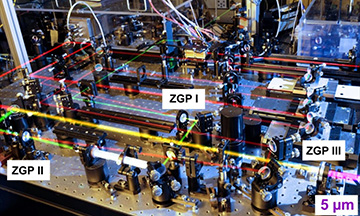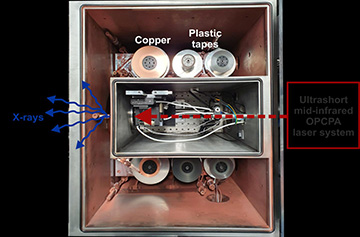
This tabletop optical driver generates femtosecond mid-IR pulses at a wavelength of 5 μm. Nonlinear zinc germanium phosphide (ZGP) crystals serve for pulse amplification. Intense mid-IR pulses refocused onto copper tape generate hard X-rays with a high, stable photon flux. [Image: MBI]
Imaging electrons, atoms and molecules in space and time is a long- sought goal for many researchers. But the hard X-ray sources needed to capture such images can be accessed only at a few large user facilities around the world or from tabletop setups not quite up to the task.
Now, researchers at Germany’s Max Born Institute for Nonlinear Optics and Short Pulse Spectroscopy (MBI), have developed a tabletop high-flux hard X-ray source that they say bests other tabletop sources for such condensed-matter research (Opt. Lett. doi: 10.1364/OL.409522). The setup could reportedly be used for X-ray diffraction studies aimed at providing new insight into basic physical and functional properties of materials.
Laser-driven X-rays
“Table-top hard X-ray sources hold strong potential for femtosecond X-ray diffraction experiments,” says coauthor Azize Koç, MBI, Germany. “In contrast to early table-top sources,” she says, “laser-driven femtosecond X-ray sources at kilohertz repetition rates provide a high and stable photon flux per second, which enables measuring subtle structure changes in condensed matter.”
The concept of generating hard X-ray pulses by focusing an ultrashort laser pulse on a metal target is an established method, Koç explains. “While our group pioneered the development of kilohertz tabletop sources some 15 years ago, the enhancement of the generated X-ray flux was a major motivation for development of the new source.”
Achieving high photon flux

The copper tape target for X-ray generation, placed in a vacuum chamber. The intense mid-infrared pulses (red dashed arrow) are focused onto a 20 μm thick copper tape (intercept point of blue X-ray arrows). [Image: MBI]
The central breakthrough with the new setup, Koç says, is its high, 1-kHz repetition rate, a longer 5-µm-wavelength driving laser and a resulting X-ray photon flux 30 times higher than kilohertz sources driven by Ti:sapphire lasers.
The system features a four-stage optical parametric chirped-pulse amplifier focused on a thin copper tape. Electrons are extracted from the metal target and accelerated in a vacuum during the optical cycle, Koç explains. They reach kinetic energies of up to 100 keV and generate a highly stable K-alpha photon flux. She says the output met the group’s theoretical calculations as to what was achievable.
Finding a new focusing geometry
Asked about challenges in creating the system, Koç says the first was to build the laser system for generating mid-infrared pulses with millijoules pulse energy at high repetition rates. “The compression of the generated mid-infrared pulses down to few-cycle duration was another challenge,” she says. “Due to the long wavelength of the driving laser, a new focusing geometry onto the target was required.”
For X-ray generation with the new setup, the authors write, the 5 µm beam is focused with an off-axis parabolic mirror onto the 20-µm-thick copper tape target in the vacuum chamber. The target is moved several times per second by an electrical drive to provide a fresh target with each driving pulse.
“The setup enables femtosecond X-ray Bragg diffraction experiments with single crystalline and powder samples,” Koç says. “It also allows for using the rotating-crystal method of diffraction.”
Off the shelf, ready to go
Koç says the system is a mixture of off-the-shelf optical and electronic components as well as newly developed parts. The latter include elements for dispersion control, focusing optics and the laser–target interaction chamber with target mechanics.
“The system is ready to go,” Koç says. “Both the laser and the X-ray source are part of a new infrastructure for time-resolved X-ray diffraction experiments.”
